Many among Morocco’s key World Cup performers are already the focus of transfer speculation, with previously unknown midfielder Azzedine Ounahi garnering the most interest. The beauty of the World Cup has seen him go from obscurity to being a transfer target in less than a month.
Ounahi has attracted attention from all over the world and also seen the likes of Jose Mourinho praise him on social media and Luis Enrique after the game versus Morocco in the Round of 16. He has highly impressed former Moroccan coaches while also playing for Angers in France for almost eighteen months now.
Morocco captivated the hearts of people all around the globe despite not having the good fortune to defeat Croatia in the third-place match. This tactical analysis, presented in the format of a scout report, will look into his breakout performance with Morocco under Walid Regragui and his tactics.
Player profile and position under Regragui
The 22-year-old has been used as an attacking midfielder in a 4-1-4-1 formation, slightly above Sofyan Amrabat, a defensive midfielder who has also excelled in this competition. In the team’s opening match against Croatia, Ounahi played on the right side of the field, and in their second match against Belgium, he also experimented with playing on the left.
He was placed to the right side by Regragui because it was more practical, and for the remaining matches, he was combined with Chelsea winger Hakim Ziyech and PSG star Achraf Hakimi. In contrast to the left, where Noussair Mazraoui played left back and Sofiane Boufal played left wing, he established a better combination on the right side.

Above is the lineup image of Morocco’s ideal formation and players. Ounahi was chosen to hold more responsibility in the centre combined with Amrabat to protect the centre.
Being a right-footed midfielder, Regragui liked to utilise him on the right, where he saw the finest link-up moves with a lot of talent to go with them. His 9 completed dribbles throughout the competition put him just behind attackers like Memphis Depay and Vinicius Junior.
Best link-up plays to progress
Ounahi’s enthusiasm in the centre of the field helped Morocco’s build-up and counterattacking phases go smoothly throughout the World Cup. His dribbling abilities undoubtedly helped Morocco generate the momentum needed to use a playmaking strategy to enter the final third. Because of his attacking talent and capacity to go beyond the mid and high block, he has been the best choice.
Morocco faced Croatia in the third-place game and had to overcome a mid-block. The first-time pass from Ounahi was well-timed to Ziyech, who was positioned inside Croatia’s defensive structure as shown in the illustration below.

Throughout the whole tournament, Mateo Kovačić, who was exceptional in his pressing, was often the one to provide pressure to Ounahi in the right centre of the field. To relieve the pressure, Ounahi gathers his quick feet, makes a pass, and runs behind the player as shown in the image. Ziyech was allowed to do his renowned side-to-side shifts since Hakimi was in a wide area.
In the quarter-finals versus Portugal, one of his finest offensive displays resulted in 100% success with 4 out of four dribbles completed and 9 offensive duels won. In the attack, he added three more progressive runs to his statistics totals.
The situation in which Morocco was under pressure throughout this close game is seen below. When Hakimi was forced to tuck inside, Ounahi maintained his composure and set up wide to detect the space. They both then spotted Ziyech, who quickly beat the press with Ounahi and Hakimi thanks to the skilful use of his flicks.

When Morocco was under intense pressure, his elegance showed, luring more defenders to pursue him. In the present situation, his composure provides him with the advantage to dribble and pass to his teammates in space. This is seen in the shot below, as he carries the ball from the back and draws the attention of almost four Portuguese players, giving Hakimi plenty of room to run.

Nobody ever imagined a midfielder gifted to Morocco might be the finest fit for their team. Regragui took a risk by allowing the kid the freedom to run the show for an underdog team on the world stage.
His second standout offensive display came against France, as he amassed more attacking stats than any other midfielder in a tournament semifinal. His presence was felt nearly everywhere on the pitch, involving in up to 102 total actions of which 85 were successful. He won 12 out of 16 offensive duels in a semi-final against the defending champions. The world witnessed one of the greatest performances by a midfielder.
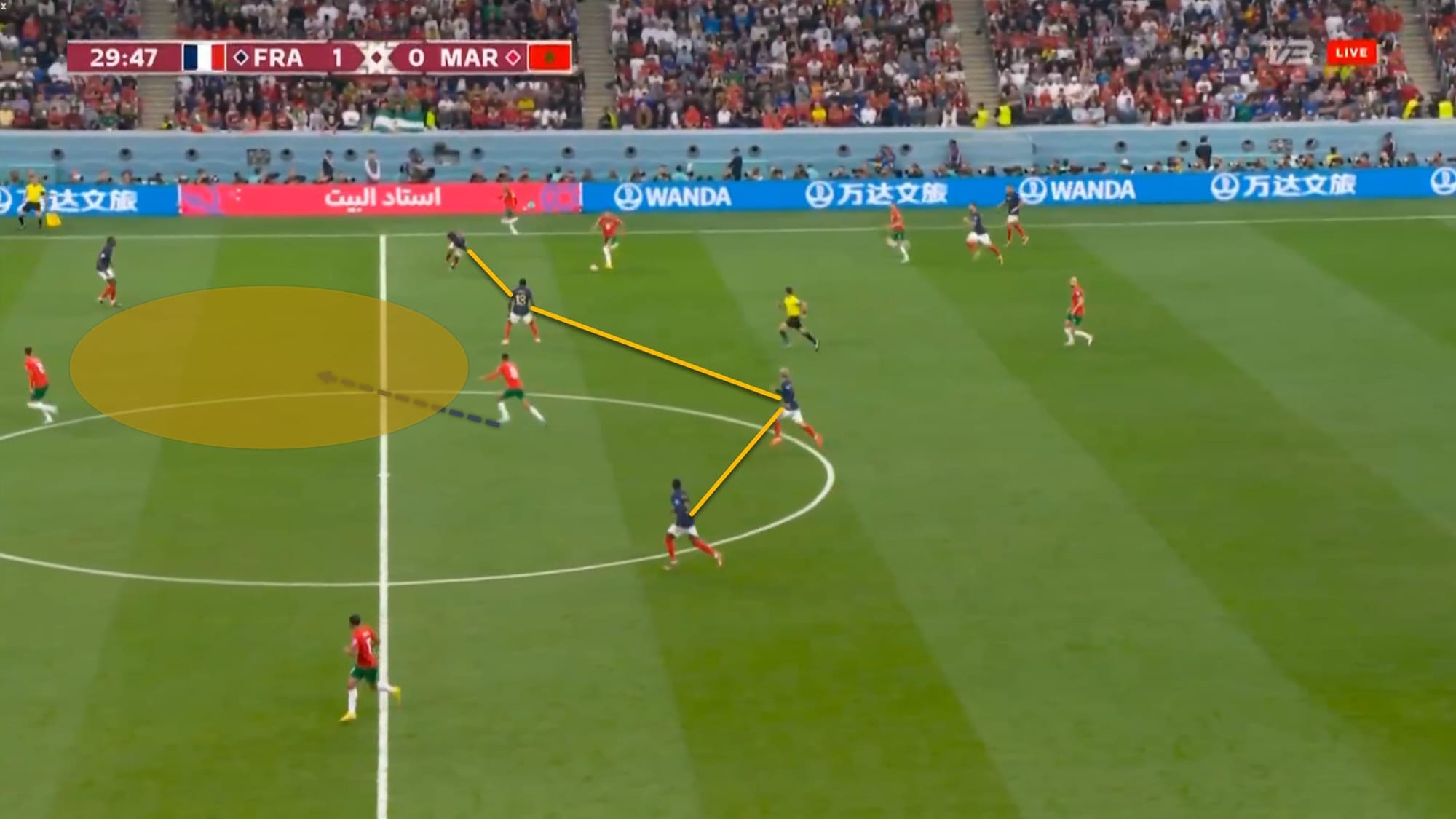
In the picture above, Ounahi is seen cutting through the midfield line to receive a ball from Hakimi on the right side. In the initial seconds, the attacker’s press proved ineffective as they attempted to recover in the scenario above. The French midfield and defensive line leave half-spaces, which Ounahi enters at the right moment.
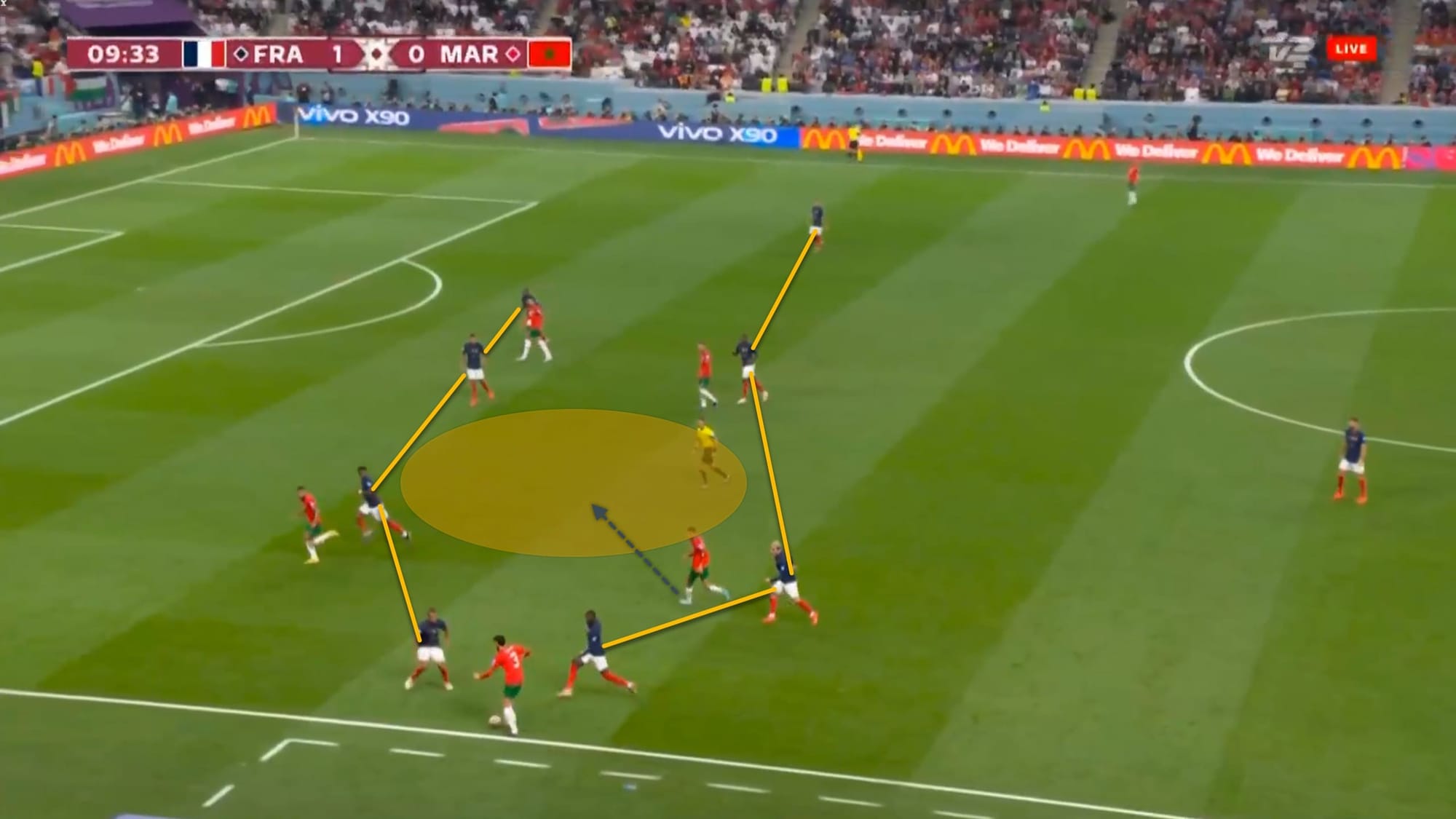
The French were unable to control Ounahi’s enthusiasm to exploit the half-spaces in this same situation. He changed the game with his relentless offensive intensity by making it seem simple to anybody who had any doubts.
Game runner for Morocco
The ability to move freely about the field and locate the optimal playmaker’s operating area proved to be the difference-maker. His output was just incredible, and he never gives up trying to move things forward.
It is possible to swiftly determine his role in Regragui’s plans by looking at his touch map over all seven of his games. He was everywhere on the pitch, giving Morocco his whole being. The picture you see below was made as a result of his desire to get more engaged in the game.

When it came to defensive or attacking actions, the youngster controlled the centre region. Every time the team had the least chance of hurting the opposition, he made himself available.
In the match against the French, Ounahi who is highlighted initiates the attack by going towards an opponent aiming to attract him in the below picture. In the meantime, Sofiane Boufal comes inside and Mazraoui moves to the wide area. This mix-up was key in leaving their markers or dragging them to create space for the dribbling Ounahi.

Jules Koundé, the right back, and Aurélien Tchouaméni in the middle of the field were forced to decide whether to mark Boufal or to defend against the incoming dribble. The aforementioned situation allowed Ounahi to dribble into the centre and break the triangle Griezmann, Dembele, and Tchouaméni were forming, which resulted in a decisive pass in the final third.
Here are all of his penetrating carries from the start of the competition until the finish. There were a total of 9 carries within the penalty area, although there were many more outside. Because of his style and ability to penetrate, Regragui had the advantage of making it work for the Moroccans.

The Spaniards were put to the test by Ounahi, who constantly tried to break the lines to undermine the opponents’ cooperation. He was the first to intervene to divide Spain’s central midfield after an aerial duel was won and the ball was with Ziyech, rushing to assist his teammate.
The connected Spanish players were Barcelona’s Pedri and Sergio Busquets, as shown in the picture below. Ounahi was ready to take advantage of Busquets’ pace and the space behind, them as soon as Pedri reacted by engaging in the duel with Ziyech. It appears that Spain’s centre-back was not aware of the opposition’s rapid burst of pace, which allowed Ounahi to create a goal-scoring opportunity.

He had exceptional dribbling skills under pressure and no opponent was able to force him out of the game. His quick look upward and attentiveness to the defenders in the area were excellent. Since he was always ready and the first to react after winning the ball, he effectively carried the ball for Morocco.
Ounahi sometimes pulls his opponent deep so that he may later use his space. Being very intelligent, he often teamed up with Ziyech to make wall passes to go around the player being pulled.
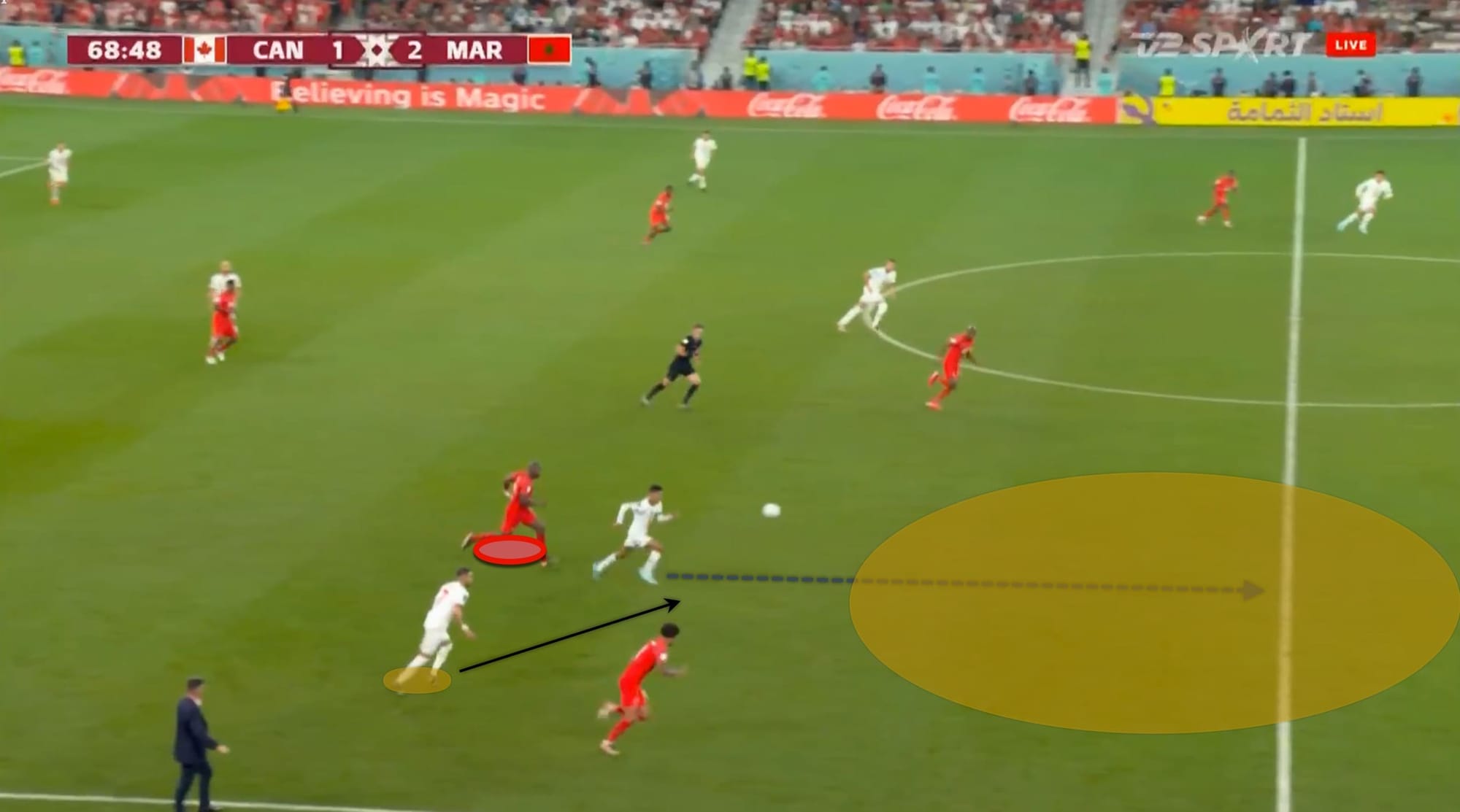
The Canadian centre-back was in the worst possible situation in the scenario above. The defender was unable to match his speed after dragging him deep to receive the ball. Ounahi would then have the significant space created by the defender as he ran toward the goal to make a pass.
Due to his help in his position, Morocco was able to build up and launch several attacks from the back. The energy and space were made accessible due to Morocco’s determination to attack. Regragui has put in place a non-stop offensive side that prefers to advance rather than sit back and play the ball.
The main man to press and intercept
To force his opponent to pass across the field instead of passing it back was the reason behind the press. Ounahi chooses the first movement to begin the press as he aggressively engages in a duel. This enabled Morocco to maintain its composure and stability even when it seemed to be defensively weak at times.
Ounahi’s awareness to cover both the defensive and the attacking midfielder at once indeed worked well for Morocco’s press. His aggressiveness played a vital role when passed inside and his awareness when the pass is played outside. He takes care of potential passes to Kevin De Bruyne and Amadou Onana in the below image.

This made the press flow more dynamic and got the midfielder working hard. To make the most of Ounahi’s relentless work rate, Regragui skillfully formulated the idea of underlining his defensive duties.
He would often start the press abruptly and dash to the defender, recovering as quickly as possible. If the ball was in possession when he did this, the other team loses the ball in the centre, and he will then start the following attack.

An example against France in the above image would prove his critical awareness by anticipating a pass by the pacy winger Kylian Mbappé. He couldn’t have defended it more wisely reacting even before the pass was released to Ousmane Dembélé. A key characteristic he possessed was his ability to anticipate and intercept the pass and quickly counter the opponent.
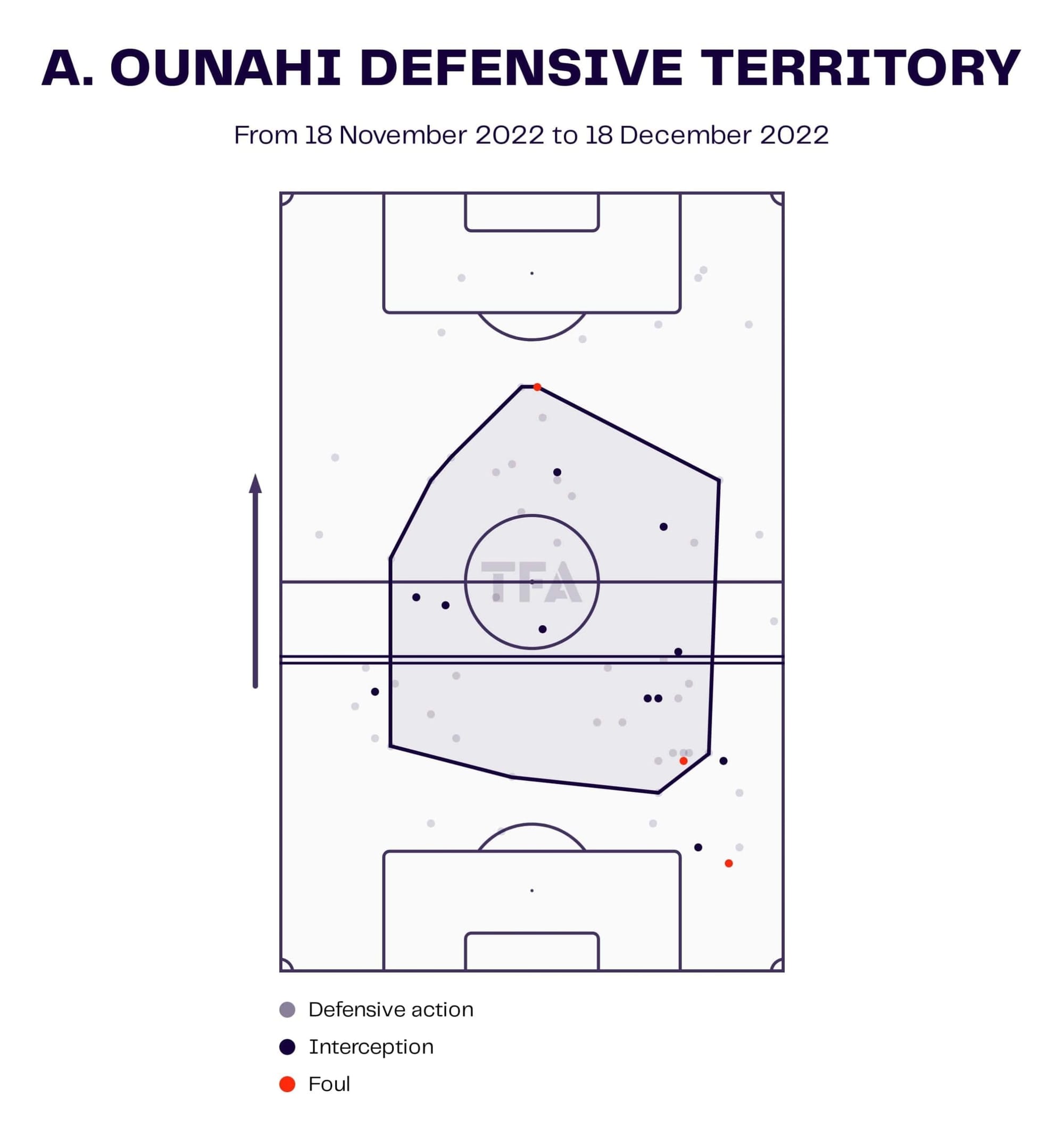
In the above graphic, Ounahi’s defensive territory throughout the whole tournament is shown. His interceptions in the centre of the pitch are evident, which explains why Morocco has prevented attacks through their pressing and defensive strategy under Regragui. The number of fouls made is as low as it can be for a statistic in the whole tournament.
His defensive actions are visible by the grey dots in the picture which explains his work rate driving up and down whenever the team needed him. Regragui was more than happy to select him in the starting eleven in six out of seven matches in the tournament.
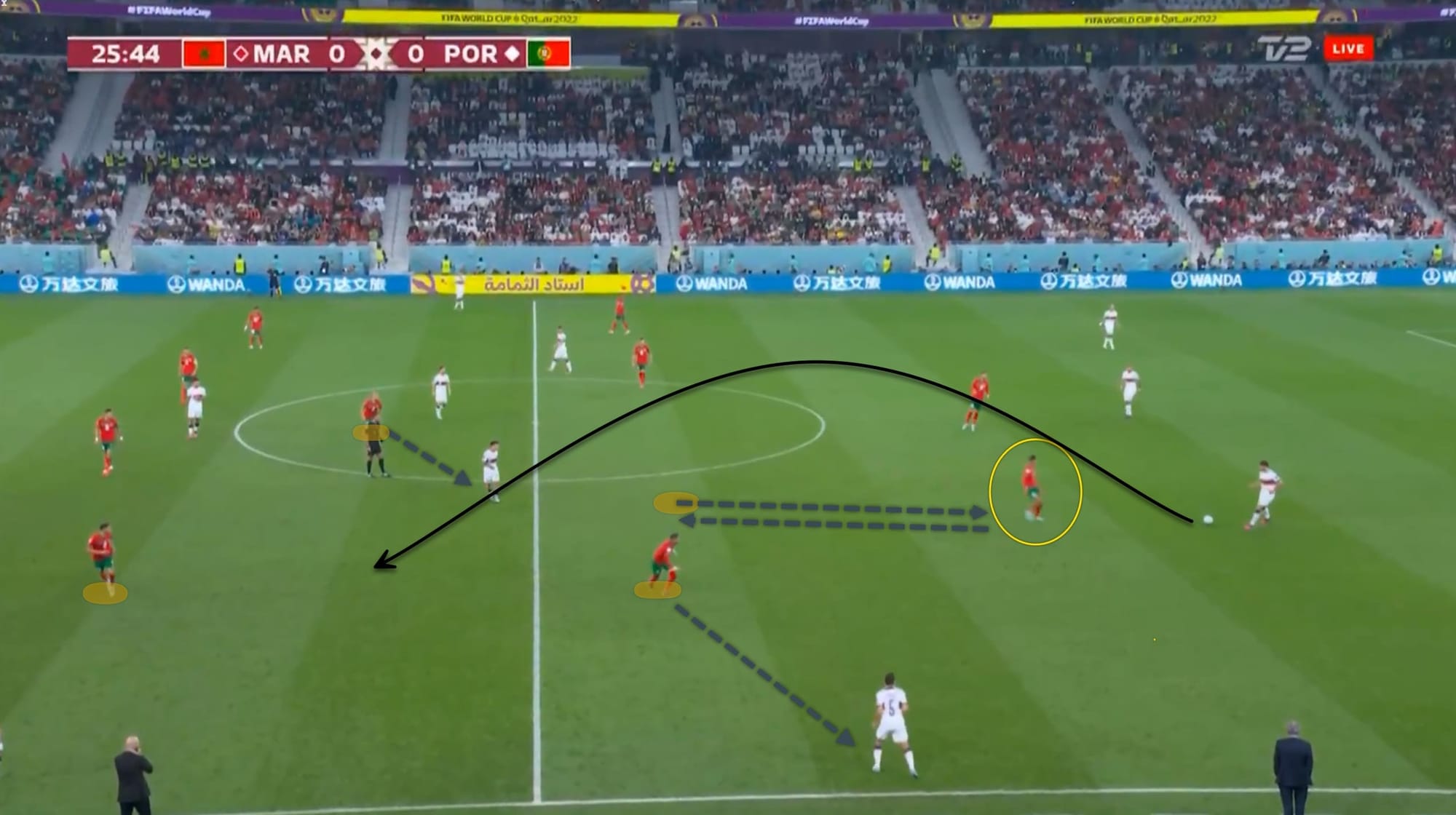
Above is an example of him leaving his right-centre portion of the field to push Ruben Dias during the match versus Portugal. He applies the quick press, which reduces the defender’s reaction time and forces the defender to pass forward rather than backward. Amrabat was there to fill the space to Ounahi’s left, as shown in the picture.

In the match against France, we see him initiating the press on Raphaël Varane, aiming to force him to make a pass in the centre. Amrabat in the image below is ready to cover Ouanhi’s left space by closing in on Antoine Griezmann in the centre. Amrabat was excellent in covering the left places by his teammates combined with aggression and composure.
Ounahi’s recovery played a vital role in reviving Morocco while defending counter-attacking situations. This enabled Morocco to make up for any game-playing deficiencies.
Conclusion
For Regragui and his team, Ounahi was the missing piece in the jigsaw that he had discovered and had expertly put in a historic tournament for the country.
It was much more convenient for the midfielder when he had to connect with two of the best players on the right side of the field. Regragui found it easier to not care about anything on the right from back to the top because of Ziyech’s flair, Hakimi’s speed, and Ounahi’s awareness.
The influence of Azzedine Ounahi on Morocco’s team throughout their record-breaking performance has been shown in the topics addressed in this analysis. He is now expected to move to one of the top European teams in the next months after drawing attention from several scouts and clubs.





Comments